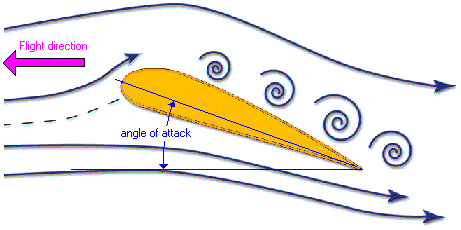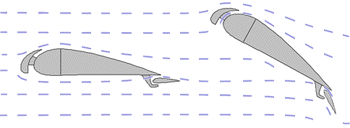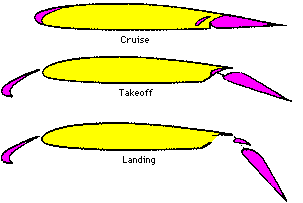- Introduction
- Wing Geometry
- Forces in Flight
- Stability Concepts
- Stall & Spin
Stall & Spin
One of the first questions a pilot might ask, when converting to a new aircraft type, is "What's the stall speed?" The reason for the enquiry is that usually, but not always, the approach speed chosen for landing is 1.3 times the stall speed. Stall is an undesirable phenomenon in which the aircraft wings produce an increased air resistance and decreased lift, which may cause an aircraft to crash.
The stall of the wing occurs when the airflow no longer can go around the airfoil's nose (leading edge) and separates from the upper wing surface. It happens when a plane is under too great an angle of attack (the angle of attack is the angle between the airfoil chord line and the direction of flight). For light aircraft, without high-lift devices, is this critical angle usually around 16°. The picture below shows a stalled airfoil:

The stall may occur during take-off or landing, just when the flight speed is low: At low speed the aerodynamic forces are smaller and, if a non-experienced pilot tries to lift the aircraft at a too low speed, it may exceed the critical angle of attack and stall occurs. The rapid reduction in speed after passing the critical angle of attack means the wing is now unable to provide sufficient lift to totally balance weight and, in a normal stall, the aircraft starts to sink, but if one wing stalls before the other, that wing will drop, the plane falls out of the air. The ground waits below.
Stalls may also occur at high airspeeds. If at max airspeed and full throttle the pilot suddenly applies excessive up elevator, the aircraft will rotate upwards, however, due to aircraft's inertia, it may continue flying in the same direction but with the wings at an angle of attack that may exceed the stall angle.
Stalling at high-speed gives a more dramatic effect than at low speed. This because the strong propeller wash causes one of the wings to stall first that combined with the high speed produces a snaproll followed by a spiral dive. This happens very fast causing the aircraft to dive at full throttle and unless there's enough height for recovery, the crash will be inevitable.
An aircraft with relatively low wing loading has a lower stall speed (wing loading is the aircraft's weight divided by the wing area). The airfoil also affects the stall speed and the max angle of attack. Many aircraft are equipped with flaps (on the wing trailing edge), and a few designs use slats (on the wing leading edge), which further lowers the stall speed and allow higher angle of attack.
Another factor that affects the aircraft's stall characteristics is the location of its centre of gravity CG. A tail-heavy aircraft is likely to stall at higher airspeed than one with the CG at the right location.
Aircraft that are designed for Short Take-Off and Landing (STOL) use slots on the wing's leading edge together with flaps on the trailing edge, which gives high lift coefficient and remarkable slow flying capabilities by allowing greater angle of attack without stalling.

Cruise Climb
The leading edge slots prevent the stall up to approximately 30 degrees angle of attack by picking up a lot of air from below, accelerating the air in the funnel shaped slot (venturi effect) and forcing the air around the leading edge onto the upper wing surface.
The disadvantage of the slots and flaps is that they produce higher drag. Since the high lift is only needed when flying slowly (take-off, initial climb, and final approach and landing) some designers use retractable devices, which closes at higher speeds to reduce drag.

Such devices are seldom used in model aircraft (especially the smaller ones), mainly due to its complexity and also the increasing of wing loading, which may counter-act the increased lift obtained.
Another method to improve an aircraft's stall characteristics is by using wing washout, which refers to wings designed so that the outboard sections have a lower angle of attack than the inboard sections in all flight conditions.

The outboard sections (toward the wing tips) will reach the stalling angle after the inboard sections, thus allowing effective aileron control as the stall progresses. This is usually achieved by building a twist into the wing structure or by using a different airfoil in the outboard section. A similar effect is achieved by the use of flaps.
The aileron drag is a further factor that may cause an aircraft to stall. When the pilot applies aileron to roll upright during low speed, the downward movement of the aileron on the lower wing might take an angle on that part of the wing past the critical stall angle. Thus that section of wing, rather than increasing lift and making the wing rise, will stall, lose lift and the aircraft < instead of straightening up, will roll into a steeper bank and descend quickly.
Following configurations are often used to reduce aileron drag:
- Differential ailerons where the down-going aileron moves through a smaller angle than the up-going.
- Frise ailerons, where the leading edge of the up-going aileron protrudes below the wing's under surface, increasing the drag on the down-going wing.
- And the wing washout.
Stall due to aileron drag is more likely to occur with flat bottom wings. Since differential ailerons will have the opposite effect when flying inverted, some aircraft with symmetrical airfoils designed for aerobatics don't use this system. The picture below illustrates an example of a Frise aileron combined with differential up/down movement.

Recovering from a stall:
In order to recover from a stall, the pilot has to reduce the angle of attack back to a low value. Despite the aircraft is already falling toward the ground, the pilot has to push the stick forward to get the nose even further down. This reduces the angle of attack and the drag, which increases the speed.
After the aircraft gained speed and the airflow incidence on the wing becomes favourable, the pilot may pull back on his stick to increase the angle of attack again (within allowable range) restoring the lift. Since recovering from a stall involves some loss of height, the stall is most dangerous at low altitudes.
Engine power can help reduce the loss of height, by increasing the velocity more quickly and also by helping to reattach the flow over the wing. How difficult it is to recover from a stall depends on the plane. Some full-size aircraft that are difficult to recover have stick shakers: the shaking stick alerts the pilot that a stall is imminent.
Spin
A worse version of a stall is called spin, in which the plane spirals down. A stall can develop into a spin through the exertion of a sidewise moment. Depending on the plane, (and where its CG is located) it may be more difficult or impossible to recover from a spin. Recovery requires good efficiency from the tail surfaces of the plane; typically recovery involves the use of the rudder to stop the spinning motion, in addition to the elevator to break the stall. However the wings might block the airflow to the tail. If the centre of gravity of the plane is too far back, it tends to make recovery much more difficult.
Another circumstance that may cause loss of control is when a hinged control surface starts to flutter. Such flutter is harmless if it just vibrates slightly at certain airspeed (possibly giving a kind of buzzing sound), but ceases as soon as the airspeed drops. In some cases however, the flutter increases rapidly so that the model is no longer controllable. The pilot may not be aware of the cause and suspect radio interference instead. To reduce the flutter, the control linkages should not be loosely fitted and the push rods should be stiff. In some difficult cases, the control surface has to be balanced so that its centre of mass (gravity) is ahead of the hinge line:

